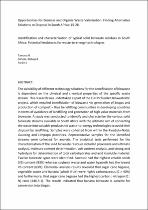 ResearchSpace
ResearchSpace
Identification and characterisation of typical solid biowaste residues in South Africa: Potential feedstocks for waste-to-energy technologies
JavaScript is disabled for your browser. Some features of this site may not work without it.
- ResearchSpace
- →
- Research Publications/Outputs
- →
- Book Chapters
- →
- View Item
| dc.contributor.author |
Tawona, N

|
|
| dc.contributor.author |
Sithole, Bishop B

|
|
| dc.contributor.author |
Parkin, J

|
|
| dc.date.accessioned | 2019-03-20T12:04:22Z | |
| dc.date.available | 2019-03-20T12:04:22Z | |
| dc.date.issued | 2018 | |
| dc.identifier.citation | Tawona, N., Sithole, B.B. and Parkin, J. 2018. Identification and characterisation of typical solid biowaste residues in South Africa: Potential feedstocks for waste-to-energy technologies. Opportunities for Biomass and Organic Waste Valorisation: Finding Alternative Solutions to Disposal in South Africa, pp. 15-28 | en_US |
| dc.identifier.isbn | 978-1-77615-010-6 | |
| dc.identifier.uri | http://hdl.handle.net/10204/10809 | |
| dc.description | Due to copyright restrictions, the attached PDF file only contains the abstract of the full text item. For access to the full text item, please consult the publisher's website. | en_US |
| dc.description.abstract | The suitability of different technology solutions for the beneficiation of biowaste is dependent on the physical and chemical properties of the specific waste stream. This research was undertaken as part of the EU FP7 funded Biowaste4SP project, which entailed beneficiation of biowaste via generation of biogas and production of compost – thus benefitting communities in developing countries in terms of avoidance of landfilling and generation of high value materials from biowaste. A study was conducted to identify and characterise the various solid biowaste streams available in South Africa with the ultimate aim of converting the waste into valuable products via waste-to-energy technologies to avoid their disposal by landfilling. Samples were collected from within the KwaZulu-Natal, Gauteng and Limpopo provinces. Representative samples for the identified streams were collected for analysis. The analytical tests performed for the characterisation of the solid biowaste residues included proximate and ultimate analysis, moisture content determination, ash content analysis, and strong acid hydrolysis for determination of total carbohydrates and acid insoluble material. Twelve biowaste types were identified. Sawdust had the highest volatile solids (VS) content (93%) whereas soybean waste and water hyacinth had the lowest VS content (63%). Elemental analysis results revealed that sugar cane bagasse, vegetable waste and banana (whole fruit) were highly carbonaceous (C > 40%) and furthermore, that sugar cane bagasse had the highest carbon : nitrogen (C : N) ratio (246.6:1). The results indicated that banana biowaste is suitable for conversion into biogas. | en_US |
| dc.language.iso | en | en_US |
| dc.publisher | Routledge, also UNISA Press | en_US |
| dc.relation.ispartofseries | Worklist;21841 | |
| dc.relation.ispartofseries | Worklist;18526 | |
| dc.subject | Bioresidues | en_US |
| dc.subject | Biowaste | en_US |
| dc.subject | Volatile solids | en_US |
| dc.subject | Waste-to-energy | en_US |
| dc.title | Identification and characterisation of typical solid biowaste residues in South Africa: Potential feedstocks for waste-to-energy technologies | en_US |
| dc.type | Book Chapter | en_US |
| dc.identifier.apacitation | Tawona, N., Sithole, B. B., & Parkin, J. (2018). Identification and characterisation of typical solid biowaste residues in South Africa: Potential feedstocks for waste-To-Energy technologies., <i>Worklist;21841</i> Routledge, also UNISA Press. http://hdl.handle.net/10204/10809 | en_ZA |
| dc.identifier.chicagocitation | Tawona, N, Bishop B Sithole, and J Parkin. "Identification and characterisation of typical solid biowaste residues in South Africa: Potential feedstocks for waste-to-energy technologies" In <i>WORKLIST;21841</i>, n.p.: Routledge, also UNISA Press. 2018. http://hdl.handle.net/10204/10809. | en_ZA |
| dc.identifier.vancouvercitation | Tawona N, Sithole BB, Parkin J. Identification and characterisation of typical solid biowaste residues in South Africa: Potential feedstocks for waste-to-energy technologies.. Worklist;21841. [place unknown]: Routledge, also UNISA Press; 2018. [cited yyyy month dd]. http://hdl.handle.net/10204/10809. | en_ZA |
| dc.identifier.ris | TY - Book Chapter AU - Tawona, N AU - Sithole, Bishop B AU - Parkin, J AB - The suitability of different technology solutions for the beneficiation of biowaste is dependent on the physical and chemical properties of the specific waste stream. This research was undertaken as part of the EU FP7 funded Biowaste4SP project, which entailed beneficiation of biowaste via generation of biogas and production of compost – thus benefitting communities in developing countries in terms of avoidance of landfilling and generation of high value materials from biowaste. A study was conducted to identify and characterise the various solid biowaste streams available in South Africa with the ultimate aim of converting the waste into valuable products via waste-to-energy technologies to avoid their disposal by landfilling. Samples were collected from within the KwaZulu-Natal, Gauteng and Limpopo provinces. Representative samples for the identified streams were collected for analysis. The analytical tests performed for the characterisation of the solid biowaste residues included proximate and ultimate analysis, moisture content determination, ash content analysis, and strong acid hydrolysis for determination of total carbohydrates and acid insoluble material. Twelve biowaste types were identified. Sawdust had the highest volatile solids (VS) content (93%) whereas soybean waste and water hyacinth had the lowest VS content (63%). Elemental analysis results revealed that sugar cane bagasse, vegetable waste and banana (whole fruit) were highly carbonaceous (C > 40%) and furthermore, that sugar cane bagasse had the highest carbon : nitrogen (C : N) ratio (246.6:1). The results indicated that banana biowaste is suitable for conversion into biogas. DA - 2018 DB - ResearchSpace DP - CSIR KW - Bioresidues KW - Biowaste KW - Volatile solids KW - Waste-to-energy LK - https://researchspace.csir.co.za PY - 2018 SM - 978-1-77615-010-6 T1 - Identification and characterisation of typical solid biowaste residues in South Africa: Potential feedstocks for waste-to-energy technologies TI - Identification and characterisation of typical solid biowaste residues in South Africa: Potential feedstocks for waste-to-energy technologies UR - http://hdl.handle.net/10204/10809 ER - | en_ZA |





